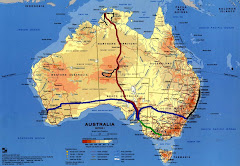What a day! We had perfect weather.
Even our driver said he recons it was one of the best days of the season.
 The Athabasca Glacier is one of the six principal 'toes' of the Columbia Icefield, located in the Canadian Rockies. Due to global warming, the glacier has receded more than 1.5 km in the past 125 years and lost over half of its volume. It currently recedes at a rate of 2-3 metres per year.[1] The glacier moves down from the icefield at a rate of several centimetres per day. Due to its close proximity to the Icefields Parkway, between the Alberta towns of Banff and Jasper, and rather easy accessibility, it is the most visited glacier in North America. The leading edge of the glacier is within easy walking distance; however, travel onto the glacier is not recommended unless properly equipped. Hidden crevasses have led to the deaths of unprepared tourists.
The Athabasca Glacier is one of the six principal 'toes' of the Columbia Icefield, located in the Canadian Rockies. Due to global warming, the glacier has receded more than 1.5 km in the past 125 years and lost over half of its volume. It currently recedes at a rate of 2-3 metres per year.[1] The glacier moves down from the icefield at a rate of several centimetres per day. Due to its close proximity to the Icefields Parkway, between the Alberta towns of Banff and Jasper, and rather easy accessibility, it is the most visited glacier in North America. The leading edge of the glacier is within easy walking distance; however, travel onto the glacier is not recommended unless properly equipped. Hidden crevasses have led to the deaths of unprepared tourists. The glacier is approximately 6 km long, covers an area of 6 km², and is measured to be between 90 metres and 300 metres thick.
The glacier is approximately 6 km long, covers an area of 6 km², and is measured to be between 90 metres and 300 metres thick.See the little 'river' of melt water on the left hand side in the picture.
But even though 60% of the glacier melted, the glacier is only 2% of the mighty Columbia Ice field.
But even though 60% of the glacier melted, the glacier is only 2% of the mighty Columbia Ice field.
Glaciers are born when snow falls onto of snow year after year without melting. When the snow layer becomes up to 300m thick the lowest layer turns into ice due to the pressure of the layers above.
 A special constructed vehicle to operate on the ice safely. Costs up to $1.3 million and only 23 operate worldwide. 22 on the Ice field and one on the north pole.
A special constructed vehicle to operate on the ice safely. Costs up to $1.3 million and only 23 operate worldwide. 22 on the Ice field and one on the north pole.
Ice Ice baby... Ice Age!!!
 Tyres big enough to sit in. You get the point?!
Tyres big enough to sit in. You get the point?! mountains formed by wedging glaciers.
mountains formed by wedging glaciers.Yes those guys have come a looong way.
 This is the steepest slope in Nothern America which is operated in order to get passengers somewhere... At least that is what they tell you.
This is the steepest slope in Nothern America which is operated in order to get passengers somewhere... At least that is what they tell you.
 Hector Lake is a small glacial lake in western Alberta, Canada. It is located on the Bow River, in the Canadian Rockies.
Hector Lake is a small glacial lake in western Alberta, Canada. It is located on the Bow River, in the Canadian Rockies.
It is named after James Hector, a geologist and naturalist with the Palliser Expedition.
 This is the steepest slope in Nothern America which is operated in order to get passengers somewhere... At least that is what they tell you.
This is the steepest slope in Nothern America which is operated in order to get passengers somewhere... At least that is what they tell you.  Hector Lake is a small glacial lake in western Alberta, Canada. It is located on the Bow River, in the Canadian Rockies.
Hector Lake is a small glacial lake in western Alberta, Canada. It is located on the Bow River, in the Canadian Rockies.It is named after James Hector, a geologist and naturalist with the Palliser Expedition.
 A special hut next to Bow Lake.
A special hut next to Bow Lake. Bow Lake is a small lake in western Alberta, Canada. It is located on the Bow River, in the Canadian Rockies, at an altitude of 1920 m.
Bow Lake is a small lake in western Alberta, Canada. It is located on the Bow River, in the Canadian Rockies, at an altitude of 1920 m.












No comments:
Post a Comment